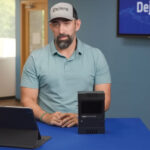Lawo HOME Apps: Think Outside the Box

Posted on Jun 6, 2023 by FEED Staff
Sponsored editorial
The ability to grow and shrink your hybrid infrastructure is tantalising. Lawo HOME Apps provide this and more
With its HOME Apps, Lawo has embarked on a path involving standard servers.
This isn’t actually anything new; its VSM broadcast control system and theWALL software for configuring of multiviewers have always run on commercial off-the-shelf servers. The shift does, however, mean that video processing will no longer require Lawo-branded, software-definable FPGA hardware. If this sounds a little too futuristic for comfort, fear not. HOME, Lawo’s overarching management system, and the VSM broadcast control system, are here to ensure that your existing hardware will still be precious going forward.
More importantly, HOME Apps can be spun up and configured simply by pressing the ‘New App’ button, selecting the processing type and setting the available parameters.
Logically Speaking
As the broadcast and AV industries continue changing faster and faster, new delivery channels, a variety of source and destination formats and ever tighter budget constraints become the new reality. Coupled with the emergence of new entrants that do things differently, it was high time for a solution that’s able to keep pace with new developments as they emerge.
An app-based approach offers the ability to change course without replacing compute hardware on-site or in your data centre. For those wary of software subscriptions, Lawo is pleased to announce that operators will remain in the driver’s seat.
Unlike other software-based schemes, Lawo’s HOME Apps allow operators to purchase perpetual licences that are functionally identical to those for the vm-series apps they know from the V__matrix platform.
The main benefit will be that changing bandwidth requirements no longer require the replacement of processing blades. Instead, the network interface card (NIC) on the standard server can be exchanged for a higher-bandwidth one when necessary. This is only one of the benefits of abstracting the broadcast and media processing functionality from the hardware.
Give me more
Lawo’s HOME Apps can be spun up wherever it’s most convenient for the job at hand: on-premise, in an OB truck, a private cloud (remote data centre) or the public cloud.
This is precious for peak moments such as football tournaments, song contests, award ceremonies and elections – situations that require more processing capability than a broadcaster or broadcast service provider needs for the rest of the year.
Planning for exceptional events before ordering new hardware used to be a delicate job; specifying too much hardware for cruise-speed operation meant long idle times for certain devices. An approach like this has become increasingly unsustainable.
Plus, hardware you purchase may be obsolete or too slow in a year’s time due to the migration to UHD and HDR, etc. Some flavour of production-grade, lossless picture compression like JPEG XS will be required, and your existing devices may be unable to provide it.
Do the Flex: Part 1
Flexibility – or elasticity – also entails that, if it is not necessary or practical to use SMPTE ST 2110-native devices for video and audio ingest, NDI or SRT sources can be used. The quality gap is narrowing, after all, and it is often more important to cover an event than to improvise just because there are no ST 2110 devices available.
Media content is increasingly consumed on smartphones and tablets. This has in turn encouraged broadcasters to broaden their offerings by adding special-interest and pop-up OTT channels. In most cases, such productions are rather low-key, with a smaller team and fewer cameras. Since the HOME Apps also support NDI and SRT, one could envisage using more affordable hardware for such occasions.
Do the Flex: Part 2
Broadcasters are clamouring for more flexibility, which can mean anything. Is it software running on a standard server? Up to a point, because even though software has been at the heart of most dedicated processing devices for years, an off-the-shelf server may be used for completely distinctive applications at different times.
Control surfaces – mixing consoles, video switchers, cameras, I/O devices, gateways – are still needed to allow operators to get signals into and out of the system. But the tools used to process those signals can change.
Some vendors would tell you that the most straightforward solution is to simply shift all processing tasks into the cloud. Merely lifting and shifting a system, however, would be a huge pity: it imposes hardware-inspired constraints on a boundlessly flexible software architecture.
The more features a software title has, the bulkier it becomes. There are flaws to this: more compute resource is needed to perform a specific operation. If one aspect needs fixing, the entire program has to be updated. Some take months to materialise.
Smaller pieces of software are needed: compact, powerful specialists dedicated to a single processing job. In this specific scenario, the power of a processing task is derived from the collaboration of several granular apps.
Although functionally the same as routing video streams to a processing blade, the standard server approach allows operators to use the same hardware to instantly configure a multiviewer, and to later spin up an up/down/cross conversion or stream transcoding routine – or indeed to use all of them simultaneously.
If we agree bare-metal servers are best placed to do the compute heavy lifting for any task we throw at them, and if we assume that containerised apps are in pole position for an agile workflow, then spinning up additional resources – more multiviewer heads, stream transcoders, etc – remains possible while the server has compute power to spare.
When this is no longer the case, more servers can be installed – again with only finite compute power. For more flexibility, one can leverage the ability to run processes within a remote data centre or on a public cloud service.
Where the server hardware is hosted should only be dictated by the amount of data that needs to be transported and processed, by the acceptable latency and, of course, the user’s preferences.
Commercial Flexibility
Depending on how you plan your server infrastructure, three usage models can be leveraged with Lawo’s HOME Apps.
Permanent availability is an option where staple processing capability is acquired with perpetual licences. This is similar to purchasing dedicated hardware, except that the processing is performed by apps running on standard servers.
Lawo Flex is a subscription licence for processing resources with a high degree of elasticity, with frequent temporary capacity top-ups where needed. This covers all existing and future HOME Apps indiscriminately.
Hybrid permanent and flex licensing offers a mix of perpetual licences for cruise-speed usage and Lawo Flex licensing for temporary-capacity top-ups at peak times.
Usage models that involve occasional top-ups are handled via a digital wallet in HOME, which can be replenished quickly. The budget it contains has a minimum validity of one month.
HOME of the Brave
HOME Apps are orchestrated in a broad sense: the HOME App manages stream flows, services, applications and processing capacity in a lightning-fast and intuitive way. Enjoy your new-found elasticity!
Originally published in the Summer 2023 issue of FEED.











